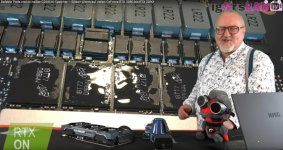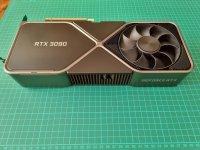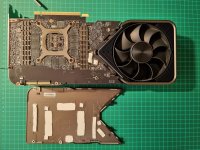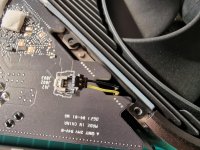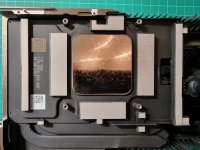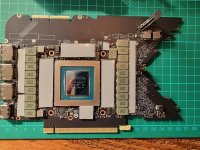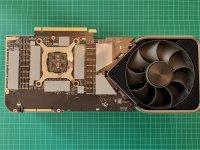I saw this thread late.
Yes I see a few problems already.
First, TM Odyssey pads are not the correct pads to use. The VRAM FRONT pad measurement is "technically correct", although scientifically, it's 1.5mm left side, and 1.6mm right side (with the V shape to the right), but the original Nvidia pads are both 1.5mm. The problem is the compression. The TR pads do not compress very well. This isn't as much of a problem on the backplate side as on the core side, but if you look at your picture, you can see that the compression of the pads is VERY low. Yes there is contact but this will slowly compromise GPU Core contact with the heatsink. I should know--I used these pads back when we were discussing the original shunt mod on overclock.net and another user suggested these pads, after a second user posted measurements with a caliper. But I was able to test with pressure paper that core contact is VERY seriously compromised by lack of compression. Using Ultra Low Prescale FujiFilm pressure paper, there was literally NO mark on the pressure paper with the TM pads!
Here is your pad compression:
https://i.imgur.com/o33KJfx.jpg
Here is Gelid Extreme 1.5mm, which are much softer. First, right side.
https://i.imgur.com/QvbiKD4.jpg
While the right (V shape closest) VRAM pads aren't quite as good as the left, they're still better than yours, and the left pads are so good, you can read the chip writings on them!
Left side:
https://i.imgur.com/FswbeCK.jpg
For comparison, these are my really old TM Odyssey 1.5mm VRAM front pads I removed when deciding to change pads long ago (the first of many changes when switching to Gelid and TFX vs SYY-157 vs Thermagic ZF-EX thermal paste).
https://i.imgur.com/1YfXsHk.jpg
Another issue is the VRM pad strips. While the first modder on overclock.net in the shunt mod thread saw the original measurements of the VRM pads, which was only given as "1.8-2.0mm" without any direct specifics here:
https://www.overclock.net/threads/o...90-owners-club.1753930/page-213#post-28666890
I determined just by looking at the 1.5mm Gelid extreme pads in the two above screenshots that I also used on the VRM's, that the left and right pads are different--the left pads have decent contact but the right pad contact is very weak, which also explains the "melt" marks due to only a small section of the pad getting all the heat. Those pads that look like that, all but one is related to NVVDD, if you superimpose Igor's picture (have to flip it around backwards). So 1.5mm Gelid Extreme pads are BARELY sufficient and 1.5mm Thermalright Odyssey pads are actually very bad if you're heavily stressing the card. My solution was to use 2.0m Gelid Extremes on the two VRM strips together, and the small solo VRM pad.
This makes logical sense since if you look at the original Nvidia pads, you can see a slightly higher compression on the right VRM strip than the left VRM strip, just slightly. Which implies the left pad is 1.8mm and the right one is 2.0mm, with the right side "gap" difference maybe 0.1mm more than the left (which compensates for the "Extra" compression of the missing 0.1mm after!).
https://i.imgur.com/oVrb1EE.jpg (not my picture!)
Your own layout is a concern for thermal paste longevity and GPU hotspot degrading (I found out that VRM temp sensors ALSO report to the hotspot!! But the delta cannot be lower than +10C above GPU Core, if it's lower than 10C in "reality", it gets pushed up to 10C), as well as if you ever push the card hard (might only happen if you're shunt modding).
However the cause of the VRAM temps being high in YOUR case is not the core side--it's the backplate side.
If you look at your picture, you can see a serious problem with the bottom left of the card. The bottom left area starts 'degrading' in contact pressure, which you can see by a slow reduction in compression. This looks bizarre because one pattern of reduction is towards the bottom left of the GPU Core area (moving upwards) on the backplate, which is "Top left" of the core on the PCB itself, since it's flipped orientation. While the second pattern is bottom left away from the core going outward (towards the SLI / NVlink connector), which is top left no the PCB, but could in fact be the entire general area! I had similar issues myself (with uneven balance) when I used TM Odyssey on the backplate side (1.5mm) and to this day I could not figure out why. I suspect some sort of warping. I tried TM Odyssey 2.0mm pads on the backplate instead and temps were 2C better, but I then tried Gelid Extreme 2.0mm and Gelid Ultimate 2.0mm and had even better results.
So I think that is the direct culprit for your temp issues.
There is a complete fix to this.
First, switch to Gelid Extreme pads. You will need one pack of 1.5mm 80mm * 40mm Gelid Extreme pads, for the GPU Core side (if you want to be safe and are worried about cutting mistakes, buy two packs just for the core--for mistake reasons--if you had money for a 3090 FE, you have money or can get money for pads), *AND* one pack of Gelid Extreme 2.0mm pads. This will do the GPU VRM's, left and right strips, then you can use the leftovers for PART Of the backplate.
Then you need a second pack of Gelid Extreme 2.0mm pads for the backplate, and you can use the remaining of the first 2.0mm and then the rest of the second one, for VRAM, and PCB hotspots if necessary. I personally use "Gelid Ultimate 2.0mm" for the backplate side ONLY (due to extremes getting gooey and sticky over time on the hot backplate side) but as long as you remember to PRE-HEAT the card for future removals--you're fine with Extremes.
So: Total Tally:
1x 85mm * 45mm Gelid Extreme 1.5mm (2 if you want to be safe): GPU Front VRAM
2x 85mm * 45mm Gelid Extreme 2.0mm for VRM Strips /single small VRM chip front side, Backplate VRAM, PCB hotspots.
Note: you can substitute Gelid Extreme 2.0mm on the backplate for Gelid Ultimate 2.0mm. Gelid is officially selling 120mm * 120mm Gelid Ultimate pads now on their own direct website. (As well as a seller on USA Amazon). Do NOT buy the Gelid Extreme 'darker grey' 120mm * 120mm pads from China however, Gelid told us that they have quality issues.
Thermal Paste: Thermalright TFX, SYY-157, FuzeIce Plus, Alseye T9+ Platinum, Zezzio thermal paste 14.3 w/mk (same exact paste as SYY-157), Kryonaut Extreme, Arctic MX-5, GD007 (only buy this from GD's official website links which point to their aliexpress certified resellers:
http://www.ourgd.net/about/?6.html ).
Picture of pad layout :
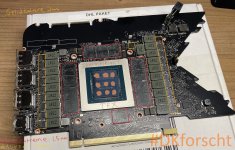


 I'll be very cautious when dubous advice like this is given. My card worked fine and now it's 10c hotter than normal and also when I compare it to my other card, it's hotter since I burnt my fingers pressing down on that area.
I'll be very cautious when dubous advice like this is given. My card worked fine and now it's 10c hotter than normal and also when I compare it to my other card, it's hotter since I burnt my fingers pressing down on that area.
